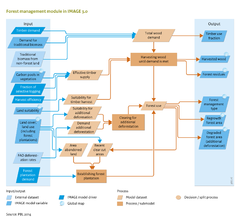Forest management: Difference between revisions
Jump to navigation
Jump to search
Oostenrijr (talk | contribs) m (Text replace - "km2" to "km<sup>2</sup>") |
No edit summary |
||
| Line 1: | Line 1: | ||
{{ComponentTemplate2 | {{ComponentTemplate2 | ||
|Application=Rethinking Biodiversity Strategies (2010) project; | |Application=Rethinking Biodiversity Strategies (2010) project; Shared Socioeconomic Pathways - SSP (2014) project; | ||
|IMAGEComponent=Drivers; Land-use allocation; Carbon cycle and natural vegetation; Energy supply and demand; | |IMAGEComponent=Drivers; Land-use allocation; Carbon cycle and natural vegetation; Energy supply and demand; | ||
|Model-Database=EFIGTM model; | |Model-Database=EFIGTM model; | ||
|KeyReference=Arets et al., 2011; | |KeyReference=Arets et al., 2011; | ||
|Reference=FAO, 2010; Carle and Holmgren, 2008; Putz et al., 2012; FAO, 2006b; Alkemade et al., 2009; Hartmann et al., 2010; | |Reference=FAO, 2010; Carle and Holmgren, 2008; Putz et al., 2012; FAO, 2006b; Alkemade et al., 2009; Hartmann et al., 2010; | ||
|InputVar=Demand traditional biomass; Land cover, land use - grid; | |InputVar=Demand traditional biomass; Land cover, land use - grid; | ||
Forest plantation demand; Land suitability - grid; Harvest efficiency; Timber demand ; Carbon pools in vegetation - grid; Fraction of selective logging; | Forest plantation demand; Land suitability - grid; Harvest efficiency; Timber demand ; Carbon pools in vegetation - grid; Fraction of selective logging; | ||
Revision as of 15:27, 2 November 2016
Parts of Forest management
| Component is implemented in: |
| Components: |
| Related IMAGE components |
| Projects/Applications |
| Key publications |
| References |
Key policy issues
- How can management influence forest capacity to meet future demand for wood and other ecosystem services?
- What are the implications of forest management for pristine and managed forest areas, and on biomass and carbon stocks and fluxes of relevance for climate policy?
- What are the prospects for more sustainable forest management and the role of production in dedicated forest plantations?
